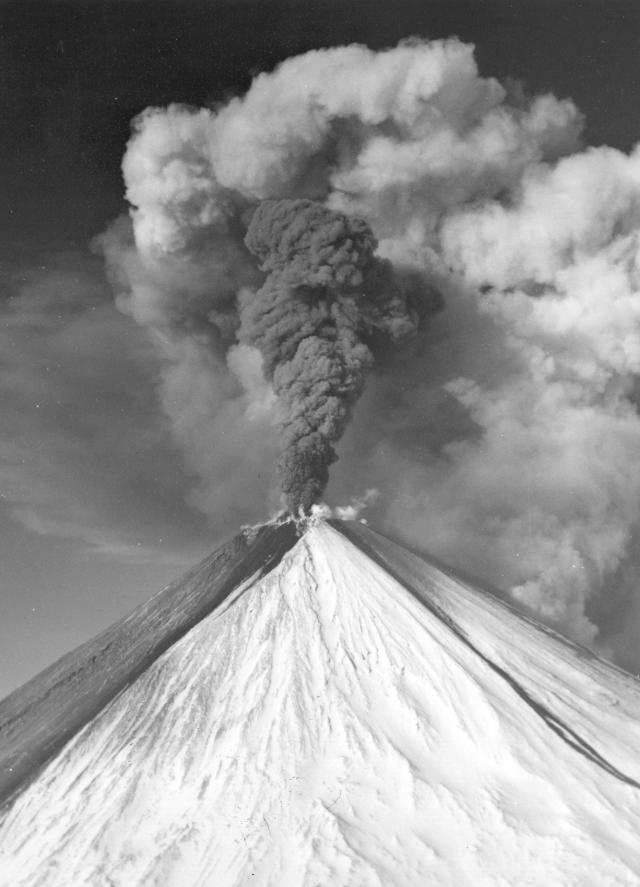Report on Klyuchevskoy (Russia) — April 1988
Scientific Event Alert Network Bulletin, vol. 13, no. 4 (April 1988)
Managing Editor: Lindsay McClelland.
Klyuchevskoy (Russia) Strong summit explosions; lava from flank fissures
Please cite this report as:
Global Volcanism Program, 1988. Report on Klyuchevskoy (Russia) (McClelland, L., ed.). Scientific Event Alert Network Bulletin, 13:4. Smithsonian Institution. https://doi.org/10.5479/si.GVP.SEAN198804-300260
Klyuchevskoy
Russia
56.056°N, 160.642°E; summit elev. 4754 m
All times are local (unless otherwise noted)
"Kliuchevskoi has been very active during the past several years. Most eruptions took place from the summit crater but there were occasional flank eruptions. The 1980 and 1983 flank eruptions were limited to effusive activity.
"A violent Vulcanian-Strombolian eruption started at the end of November 1986 and was continuing in January-February 1987. In January, the eruption column rose 1-2 km and bombs were ejected to 100-300 m height. Two or three vents were active in the central crater, forming a cinder cone. Lava flowed onto the SW and NW flanks.
"The eruption intensified in February (figure 2). Eruption column heights reached 3-4 km at times and bombs were ejected to 600 m above the crater. Lava flowed down the NE flank, reaching 3,200 m elev, 1,650 m below the summit. The most violent activity was observed on 19 February, when the eruption column rose 5.5 km and bombs reached 1 km height. Explosive intensity decreased after 20 February. On 22 February, a radial fissure opened at 3,750 m altitude on the SE flank. Lava from the fissure advanced <1 km. On 6 March a new flow originated from a fissure lower on the SE flank. Some of this lava flowed under Schmidt Glacier at 2,900 m altitude. Flank eruptions ended on 10 March. The summit cinder cone collapsed in June, forming a pit 200 m in diameter.
 |
Figure 2. Oblique airphoto of Kliuchevskoi from the NE on 9 February 1987, showing an eruption column emerging from the summit. Photo by A.B. Belousov. |
"Summit activity resumed in July. Activity was primarily Strombolian, ejecting bombs to 200-300 m height from 3-5 new vents. A weak eruption cloud rose 0.5-1 km, with occasional ash ejections to 1.5 km. Between 11 and 13 September, lava began to flow onto the NW flank, advancing about 1 km before activity became less intense in early October and ended on the 12th. The pit formed in June by cinder cone collapse was filled with another cinder cone.
"Activity resumed on 1 December when a series of explosions ejected a 0.4-1 km plume and ash and bombs that rose to 50-150 m height. A small lava flow descended the NW flank 13-24 December. Lava effusion started on the SW flank on 22 December. Activity continued into 1988."
Further Reference. Gorelchik, V.I. and Zharinov, N.A., 1988, Mechanism of Klyuchevskoy flank eruptions of 1974, 1980, 1983 and 1987 as shown by seismological and geodetical data: Proceedings, Kagoshima International Conference on Volcanoes, p. 75-78.
Geological Summary. Klyuchevskoy is the highest and most active volcano on the Kamchatka Peninsula. Since its origin about 6,000 years ago, this symmetrical, basaltic stratovolcano has produced frequent moderate-volume explosive and effusive eruptions without major periods of inactivity. It rises above a saddle NE of Kamen volcano and lies SE of the broad Ushkovsky massif. More than 100 flank eruptions have occurred during approximately the past 3,000 years, with most lateral craters and cones occurring along radial fissures between the unconfined NE-to-SE flanks of the conical volcano between 500 and 3,600 m elevation. Eruptions recorded since the late 17th century have resulted in frequent changes to the morphology of the 700-m-wide summit crater. These eruptions over the past 400 years have originated primarily from the summit crater, but have also included numerous major explosive and effusive eruptions from flank craters.
Information Contacts: G. Bogoyavlenskaya and A.B. Belousov, IV.

